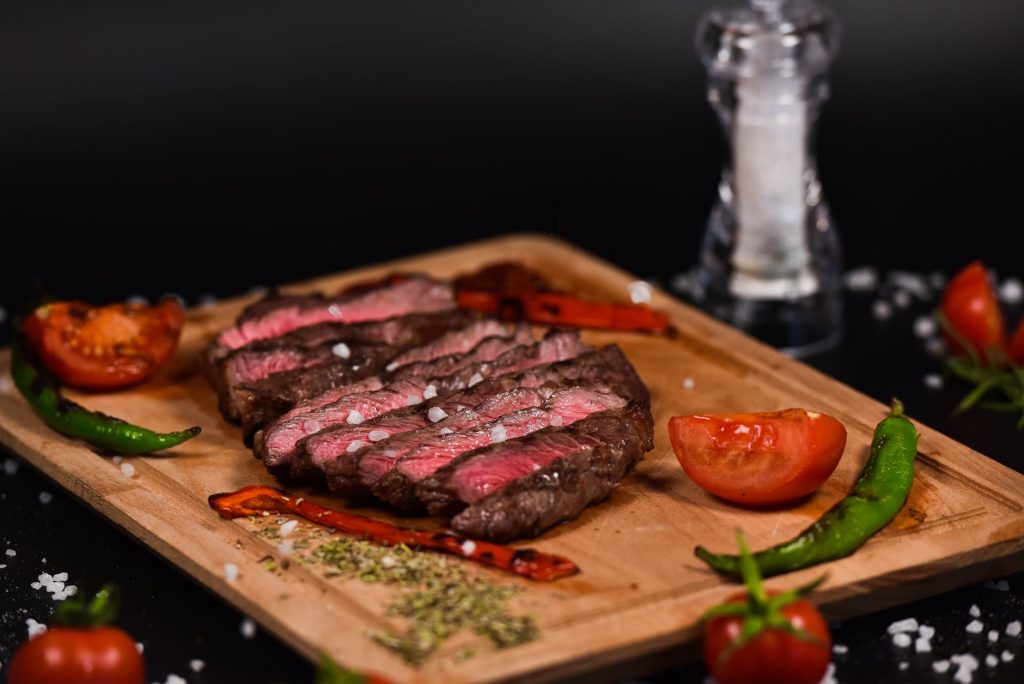Eating steak at restaurants like Capital Grille or Chop House register at least one type of cooking technique: medium rare. But what makes it so popular than other doneness ratings like Blue, or well done?
What Meat Is When Uncooked
For a baseline comparison, uncooked meat has lots of myoglobin. That’s the muscle cell equivalent of red blood cells. When left exposed to air, the myoglobins will eventually turn red from the oxygen present. That’s why it initially has a bluish or purplish color. The taste of Blue is metallic, owing to the left over blood.
Most restaurants do not serve this style of meat doneness as the safety against food poisoning is not guaranteed. Generally, Blue meat will still have a seared surface area, and aside from the metallic taste, will not have any other taste. Blue meat will usually be heavily seasoned to give it some level of taste. Texture-wise, it will be chewy and hard to swallow.
Although doneness is usually applied to steaks, and red meat cuts, “blue meat” is a better application to the already existing concept of sushi. Fish has a naturally sweet and softer meat than beef or poultry.
Doneness Levels
In French/English/Temperature, here are the doneness levels of steak:
- Bleu/Blue/125F
- Saignant/Rare/130F
- A Point/Medium Rare/140F
- Demi-Anglais/Medium/150F
- Cuit/Medium Well/155F
- Bien Cuit/Well Done/160F
- Trop Cuit/Overdone(overcooked)/Higher than 160F.
Why Is Well Done A Bad Choice?
Most health experts will readily agree that meat well done is safe to eat. The internal temperature of well done meat is enough to kill bacteria and parasites that can possibly cause an infection to the consumer. This is a valid reason. However, culinary experts, chefs, and steak connoisseurs agree that meat tastes all the same when overcooked – it’s tough, tasteless, and dry.
All the flavor of a good meat is only preserved when it’s not cooked past Medium.
The Reason Why Medium Rare is Popular Explained
A lot of people like their steaks retaining juiciness and flavor, less the parasites and food poisoning. That’s why most people at steak restaurants order medium. At medium doneness, the meat is cooked all the way through, but it is still soft enough for pleasurable consumption.
In rare doneness, the outside is already cooked, and the insides of the meat are just starting to cook. This means the collagen isn’t broken down, and the “texture” of the musculature is still intact, making it chewy and hard to eat. It has all the juice, but they’re stored in the muscle cells and don’t contribute anything to flavor.
On the opposite spectrum, a medium-well steak has a dry exterior, but still retains the taste. There’s too much juice coming out from the muscle cells individually, and most of the flavor will just be an aftertaste.
Now the debate begins on whether medium or medium rare is better. On a connoisseurial note for discussing steak, medium rare retains the maximum amount of moisture, flavor, and the right ratio of collagen breakdown that makes it equally cooked and possessing texture.
This is appreciated for meat cuts like the famous Wagyu beef which has excellent fat content (or marbling). For people who want their steaks less bloody but appreciate some flavor, medium is their choice.
Most restaurants slightly undercook steak because it’s easier to salvage. The fame of medium rare is a combination of opinion from steak experts to practicality. What customers need to keep in mind is to order steak at the doneness they want.
